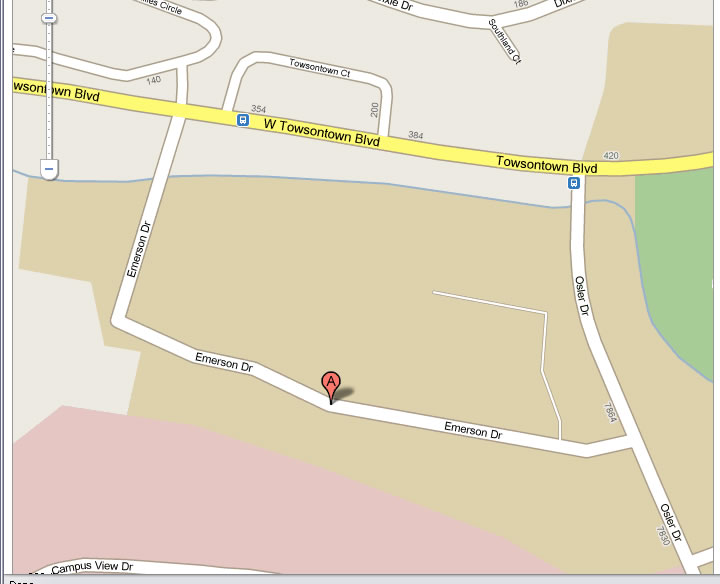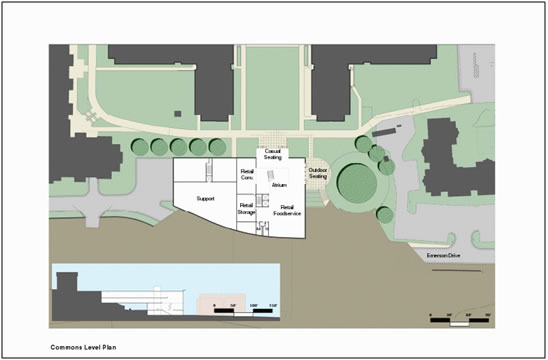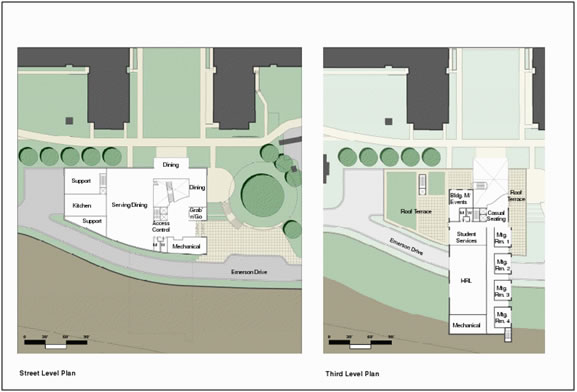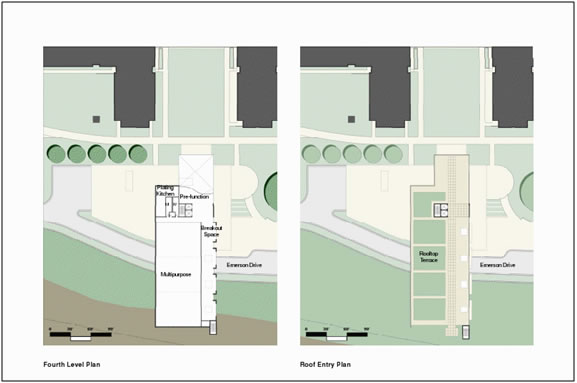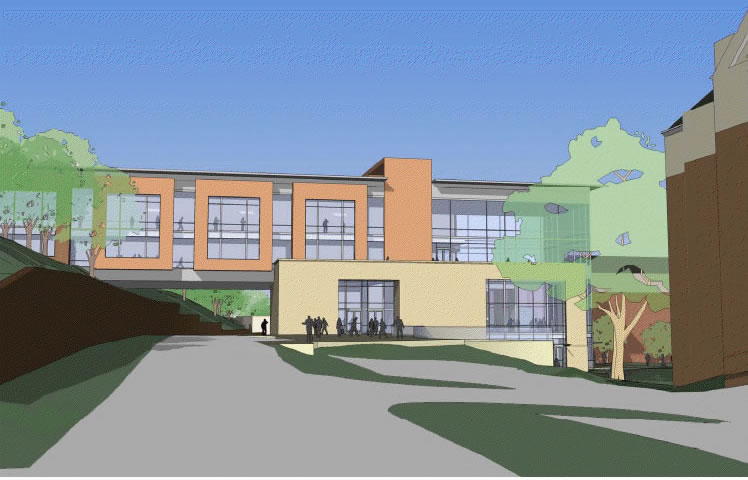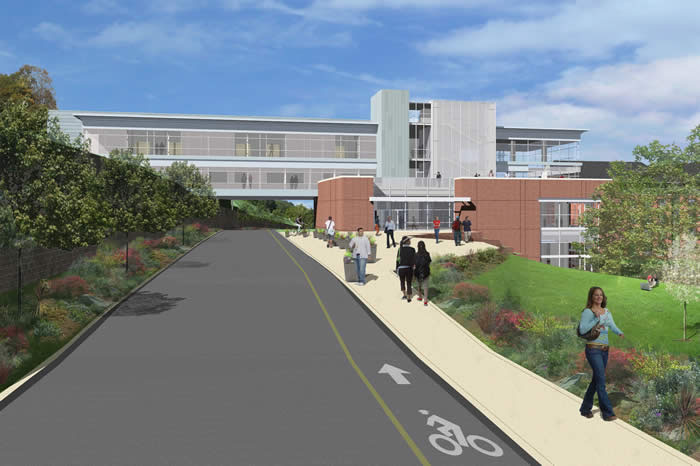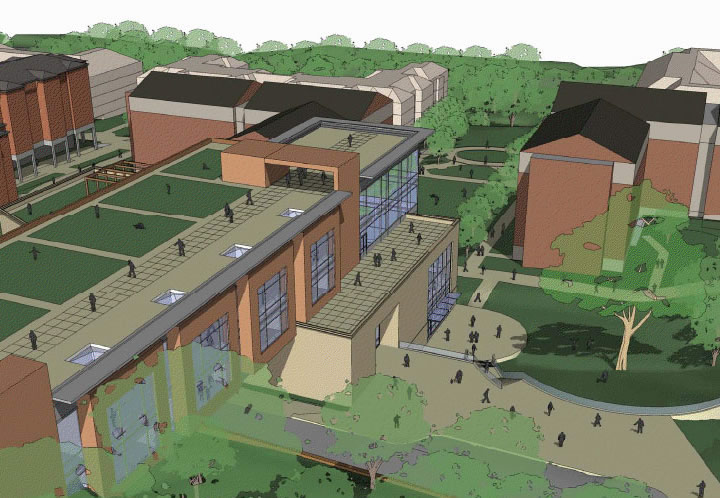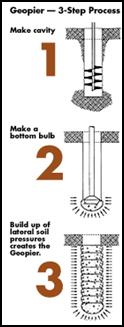-Building Statistics- |
||
|---|---|---|
General Building Statistics
|
||
| Building Name: | West Village Commons At Towson University |
|
| Location and Site: | Located on the western edge of campus between the Paca and Tubman residence halls. The top 2 floors span over Emerson Road. The address for West Village Commons is: 424 Emerson Drive Towson, Maryland, 21204 |
|
| Occupancy Type: | Mixed use dining and organizational meeting facility |
|
| Size: | 85,000 SF 4 story plus basement 67 feet from finish grade (tallest elevation) |
|
| Dates of Construction: | July 15, 2009 to February 28, 2011 (substantial completion) |
|
| Project Delivery Mode: | Design-Bid-Build |
|
Contractual Method: |
Construction Manager at Risk with GMP |
|
| GMP: |
|
|
| Project Team | ||
|---|---|---|
Owner: |
Towson University |
|
Architect: |
GWWO Inc./Architects |
|
Construction Manager:
|
Barton Malow Company |
|
Structural Engineer: |
ReSTL Engineers |
|
MEP Engineer: |
James Posey Associates, Inc. |
|
Civil Engineer: |
Site Resources Inc. |
|
Lighting Design: |
Bruce Dunlop Lighting Design, LLP |
|
Landscape Architect: |
Mahan Rykiel Associates |
|
Interior Design Consultant: |
PLDA, Inc. |
|
Food Service Design: |
Ricca Newmark Design |
|
| Construction | |||||||||
|---|---|---|---|---|---|---|---|---|---|
The West Village Commons Project is a 20.5 month project in the heart of a condensed college campus. Site logistics become quite the issue on such a tight site while school is in session. Special care in timing loud construction processes during school hours is a tough issue to build a schedule around. Barton Malow is utilizing a milestone project schedule with 21 milestone dates, and will be tracked using the critical path method. Documentation is tracked using Prolog Web with an effort to use the least amount of paper as necessary. Prolog Web is a database that allows a continued stream of information flow between parties in real time. RFI's, meeting minutes, etc... are posted directly onto the website and email notifications are sent out. The Barton Malow Company is a dedicated industry leader on not only the utilization of BIM, but also the exploration of new construction technologies and techniques. West Village Commons is benefiting from several unique construction aspects. The chart below illustrates some of the techniques:
Towson University West Village Commons was bid out in two seperate packages so that site work, foundation, and initial cast-in-place structural concrete could begin early. Below is a break down of the two packages: |
|||||||||
Bid Package "A"
GMP Package "A": $7,120,965 (Does not include preconstruction services) |
Bid Package "B"
GMP Package "B": $22,691,029 (does not include preconstruction services) |
||||||||
| Structural System | |||||||||||||||||
|---|---|---|---|---|---|---|---|---|---|---|---|---|---|---|---|---|---|
The building's foundation system consists of spread footings on natural soil for the basement and Ram Aggregate Piers® (R.A.P. or Geo Piers) for level 1. The piers have a bearing capacity of 6,000 ksf minimum and compacted fill with an allowable bearing capacity of 4,000 psf. To place the R.A.P.'s, first an auger is drilled to the geotechnical specified depth. Stone is placed in 12" lifts and pounded by an excavator equipped with a hydraulic break hammer. See Figure 9 for a cross-sectional view of the process. When properly placed, these piers not only allow direct structural support, but also strengthen the surrounding soil. With a foundation loads greater than 3,000 kips, the system will limit foundation settlement to 1 inch or less (www.geostructurs.com). The smallest footers have 6 piers each and the most have 16. All footers and grade beams shall have a compressive strength of 4000 psi and have dimensions ranging from 3' x 3' x 16" to 13' x 13' x 44". The south side of the building, where the bridge portion of the structure meets the hill, has a crawl space consisting of a 4" slab on grade and 12" thick concrete walls.
Figure 9, www.geostructures.com Superstructure: The north half of the building consists of cast-in-place concrete for all retaining walls, columns, beams, suspended slabs, and slabs on grade. This half of the building houses most of the dining commons and take-out restaurants. The abundance of mechanical piping and ductwork to support the kitchen equipment requires a larger plenum height, which cast in place concrete allows. Floor slab to floor slab height in on level 2 (location of the largest kitchen) is 17’ – 4” with a plenum height of 7’ – 4”, ample room to coordinate overhead systems. The suspended slabs are 9" thick normal weight concrete with 7 1/4" drop panels. Most of the concrete columns are 24" x 24" with 12 #8 reinforcing bars. The elevator and stairwell walls act as 12" thick shear walls reinforced with #5 reinforcing bars at 12" o.c. The slab on grade is 5" thick reinforced with 6"x6" - W2.9 x W2.9 Welded Wire Fabric (WWF). Figure 10 gives the typical concrete strengths.
When the structure reaches the third floor, the south side of the building spans over Emerson drive. The main structural component for this south section is structural steel; the overhead head mechanical support systems are less dense and therefore require less space than the north section. The steel also has the tensile resistance to span across Emerson Drive, at some points between 40 and 50 feet. On the third floor (the first floor of the bridge) the beams are larger to support the load over the road. Some of the typical beams are W18x35, W21x24, W24x55, and W24x76. The fourth floor beams are more consistent in type, only varying between bays. The four main beams are W10x12, W12x14, W12x19, and W14x22. The steel beams are mostly W12x40's with the occasional W12x45 or 50.The floors are a composite slab structure made up of 3-1/4" light weight concrete reinforced with 6"x6" - W2.1xW2.1 WWF, over a 2", 20 gauge composite steel deck on composite beams. The roof structure for the south end is utilizes 52DLH16 sloped joists with 1-1/2", 20 gauge steel decking. The roof structure for the south side of the building is made up of 52DLH16 sloped joists with 1-1/2", 20 gauge steel decking. The roof structure where the third floor steps back and the roof structure at the top of the north part of the building is 9" thick normal weight concrete. |
| Electrical System |
|---|
West Village Commons will tie into existing campus utilities and provide an outlet to future buildings on the west side of campus. Currently there are three main outdoor switch gears providing 15 kilovolts and 1200 amps each. A new switch gear with the same attributes will feed into a 1500KVA, medium voltage transformer and than into the main switchboard in the basement level. The switchboard is a 277/480 volts, 3-phase, 4-wire with a 2000 amp main breaker. A 150 kilowatt natural gas generator with 277/480 volts, 3-phase, 4-wire, will provide back up energy with in 10 seconds to the commons during a power loss. The vast amount of kitchen equipment requires a lot of energy and many electrical connections. The complicated electrical system needs close coordination between the electrical contractors and the kitchen equipment vendors. Equipment is constanly changing and the owner will want the most up to date appliances. Changes in locations of connections will have to be carefully tracked. |
| Lighting System |
|---|
The lighting system is powered by 277/480 volts, 3-phase, 4-wire power and distributed through 7 different electrical panels throughout the building. Fixtures in the larger rooms are usually fluorescent downlights or 2x2 recessed fluorescent troffers. In other areas with more of an architectural element, there are pendent surfaced mounted lights, wall washers, and decorative pendent lighting. The green roof uses underbench LED lights to allow green roof access at night, while also keeping a focus on the key architectural element.The ornamental stair has floor mounted LED lights providing pleasing touch to highlight the first floor center piece. The lighting in individual rooms utilize dimming switches and occupancy sensors which helps keep energy costs low and gives occupants more control over light. |
| Mechanical System | ||||||||||||||||||||||||||||||||||||||||||||||||
|---|---|---|---|---|---|---|---|---|---|---|---|---|---|---|---|---|---|---|---|---|---|---|---|---|---|---|---|---|---|---|---|---|---|---|---|---|---|---|---|---|---|---|---|---|---|---|---|---|
Heating Water System: The hot water system for West Village Commons consists of two packaged cast iron sectional pressureized, wet base water boiler-burners. They run off natural gas and are rated for 3000 MBH. Each weighs approximately 10,000 lbs. They are distrubuted thoughout the building by two 465 gallon per minute pumps located in the basement. Chilled Water System: The cold water source is from a chiller located in the basement. The evaporator for the chiller is 3535 MBH with a 565 gpm max flow, and will require 193 kilowatts to power it. The cold water is distributed by two 565 gpm pumps located in the basement. It works together with a closed loop condenser water system which consists of cooling tower located on the roof. The tower is rated as a 300 ton, induced draft counter flow, upblast system, with a 20 horsepower motor and a maximum flow rate of 900 gpm. The condensed water system is distributed by two 900 gpm pumps located in the basement. HVAC: The new commons building has an interesting heating, ventilating, and air conditioning system in that it has 7 separate air handling units (AHU) spread throughout the building. They provide hot or cold air to variable air terminal units, allowing greater control in each of the zones. The dining commons kitchen has its own dedicated AHU, and the 3rd and 4th floor are the largest areas supplied by one unit. Greater control means a greater expense in not only material, but also labor and coordination. AHUs 1, 2, 3, 4, and 6 are custom designed air handling units. Figure 11 is a table describing each of the AHU’s.
|
Fire Suppression/Detection |
West Village Commons furnishes a water-based, automatic fire suppression system complete with wet-pipe sprinkler and standpipe system. The system will connect with the domestic water piping to achieve a minimum static pressure of 99 psi. The two stair towers will house the sprinkler risers, where at each landing a sprinkler zone valve is installed. In areas of elevated temperatures such as the large amount of kitchen spaces, high temperature sprinkler heads will be used. The spinkler system will be coupled with an intelligent reporting fire detection program, NOTIFIER, which is a PC based graphical facilities monitoring system. It will have to power to use floor plans and Closed Caption Television cameras to monitor large areas and report information on non-normal conditions. This program works in conjuction with zoned photoelectric smoke detectors, manual pull stations, annuciating speakers and strobes, and magnetic door holders. |
Transportation
|
The transportation system consists of three elevators: 2 group elevators and 1 service elevator. All three elevators are going to be the Otis Gen-II 200 fpm. The service elevator (elevator "A") has a front and rear opening doorways, and is rated at 4,500 lb max capacity and 200 floors per minutes (fpm). It runs from the basement level to the 4th floor, and is located next to stair tower 1 in the northwest area of the building. The two group elevators (elevators "B & C") have a one side opening, and are rated for 2,500 lb max capacity and 200 fpm. They service only floors 1 through 4, and are located near staircase 2 in the northeast area of the building. All three elevators have a 5'-6" elevator pit with a sump pump, and they are powered by a variable-voltage, variable-frequency, ac-type hoist driven machine. |
Food Services |
West Village Commons will serve as a student center fully equiped with several dining options. It has already been decided that "Outtakes: Quick Cuisine," "Einstein Bros. Bagels," "Coyote Jack's," and "Jamba Juice" will be the premiere venues of choice (information on some of the restaurants can be found by clicking on their names above). There is also a comprehensive dining commons area equiped with a salad bar, "my pantry," pizza and pasta bar, and a deli. By providing these food services, a large kitchen with special systems needed to be considered in the design. These systems are mainly confined to the first and second floor in the north area of the building, though there is a small coffee shop on the fourth floor. Level 2 is home to a buffet style dining commons and a large kitchen area to support it. Some of the equipment in the kitchen includes three large walk-in coolers, a walk-in freezer, 2 double-deck ovens, heating shelves, and large hand sinks. The Level 1 tenants will also have access to a walk-in cooler and freezer, smaller appliances to their specifications, and large storage space, some of which is shared between them. The large kitchen and individual restaurants require multiple ventilation systems and exhaust
hoods. There are 11 of these hoods throughout the building that are exhausted with 6 separate
exhaust fans. They range from 800 cfm to 8300 cfm and are located on either Level 3 or Level 4
roof. In addition to the exhaust fans, a 2,000 gallon grease interceptor will be installed below grade
and connected to all pieces of equipment with grease waste products.
|
